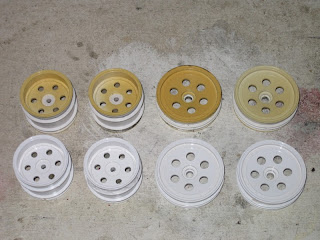It is now only two months after release and this limited-production kit is already sold out at many online retailers and is becoming harder to find at local hobby stores. Actual production numbers were not disclosed, but some people think the total number of kits produced was around 2500. Many people were surprised at how quickly the kits were bought up, and others were shocked and disappointed at how the allocation and distribution of the kits was handled.
The box presentation is similar to the original. Associated used the same picture of the RC10 flying through the air off a dirt mound as the original box. The parts are very similar to the original, too, but with some updates necessary for 2013, such as the ability to handle mild brushless motors and LiPo battery packs. Other more subtle modifications were made to most parts in order to differentiate the re-release parts from original parts, which is a good thing for vintage collectors and restorers.
One thing to note here is that the re-release kit was not made in the USA like the original, at least not all of it. Some parts were made in the US, such as the tires (by Proline) and gold anodized aluminum parts, but the rest of the parts were manufactured somewhere else, like China. The actual kit boxing was done in China.
When the kit box is opened, you are greeted by a sight very similar to the original. Many bags of parts.
 |
| Proline tires and three-piece wheels |
The original kit included bushings and so does the re-release. It is highly recommended to purchase ball bearings in order to reduce wear and friction. You will need the following ball bearings:
| Inner diameter | Outer diameter | Style | Quantity |
| 3/16" | 5/16" | flanged | 9 |
| 3/16" | 5/16" | unflanged | 2 |
| 3/8" | 5/8" | unflanged | 2 |
| 1/4" | 3/8" | flanged | 5 |
The original kit used a 32P spur gear, but the re-release uses a 48P spur. The internal gears, however, are still 32P.
The kit does not include a motor or 48P pinion gear. The recommended pinion size is around 18 teeth when using a 27T stock brushed motor. Associated does not recommend using a brushless motor less than 8.5 turns.
 |
| Six gear transmission, rear arms and battery holder |
 |
| Shocks, spur cover, ball ends, steering parts and shock tower |
 |
| Tie rods, gold aluminum nose and motor plate, front suspension parts |
 |
| Gold anodized aluminum tub |
 |
| Driver and rear wing |
 |
| Body |
A slip of paper like this one is included in each kit box. Parts bags were checked off as each one was added to the box. The online forums have already determined that the number at the bottom (2216) is not the kit number because many people have the same number. It is likely to be the identification number of the person that performed the box contents inspection (quality assurance).
 |
| Quality control sheet |
 |
| Decals, manual and antenna tube |
Two different sets of decals are included.
 |
| Decal sheets |
The manual is similar to the original but has been updated for the re-release.
 |
| Assembly manual |
There are some assembly issues to be aware of. The RC10 experts at RC10Talk.com have compiled a list at this link: http://www.rc10talk.com/viewtopic.php?f=88&t=33130
In addition to that excellent reference, there are many other threads discussing the re-released RC10, so feel free to check them out and post your own experiences and opinions.
As for spare parts, Team Associated has stated that there will be plenty of spares available for a long time, so there should not be any worries of not being able to get spares of broken or worn out parts.
Due to the plethora of spare parts availability it is possible to "build your own kit", given that the re-release kit is now hard to find, however the cost of doing so would be much higher than the kit price of $250 US.
In addition to spare parts, Team Associated has released hop-up parts for the RC10 Classic, as it is called, including black anodized aluminum tub, motor mount and nose plate, bellcrank steering kit, and more. There is speculation that a re-released stealth transmission will be available in the future.
As a long-time Tamiya fan who has thoroughly enjoyed the re-releases over these past few years, I am glad that Team Associated decided to re-release the RC10. It is truly a classic racing vehicle that changed how future car designs would be made and it's nice to be able to build one from scratch.
























































